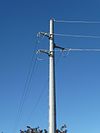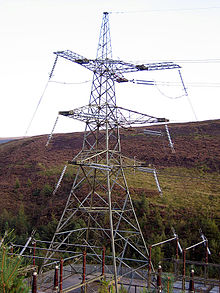- Dead-end tower
-
A dead-end tower (also anchor tower, anchor pylon)[1] uses horizontal strain insulators and occur at the endpoints of conductors. Such endpoints are necessary when interfacing with other modes of power transmission (see image) and, due to the inflexibility of the conductors, when significantly altering the direction of the tower line. Anchor pylons are also employed at branch points as branch pylons and must occur at a maximum interval of 5 km, due to technical limitations on conductor length. Conductors are connected at such pylons by a short conductor cable "strained" between both ends. They often require anchor cables to compensate for the asymmetric attachment of the conductors. Therefore, anchor pylons tend to be more stably built than suspension towers and are often used, particularly in older construction, when the power line must cross a large gap, such as a railway line, river, or valley.
A special kind of an anchor pylon is a termination pylon. It is used for the transition of an overhead powerline to an underground cable. A termination pylon, at which the powerline runs further as well as overhead line and as underground cable is a branch pylon for a cable branch. For voltages below 30 kV also pylon transformers are used.
For crossings of large bodies of water, wide freeways, or valleys, where the span width of the conductors is very long, specific constructions must be used to achieve a wider distance between the conductors, mostly to prevent short-circuits which may occur when conductors come in contact with one another due to wind or other interferences. These towers may be built as H-frame towers, or may have each conductor placed on a single tower or mast. In every case, these towers are built more stably than most of the other towers used, as the wide span between towers means that much greater forces are placed on these towers.
Anchor pylons may also have a circuit breaker attached to their crossbeam. These so called switch pylons are operated from the ground by the use of long rods. The attachment of circuit breakers to pylons is only practical when voltages are less than 50 kV.
Sequences of two or more strainer pylons are uncommon in a powerline[citation needed] because strainers require twice as many strain insulators as ordinary pylons. Longer wire sections thus reduce installation work and cost. Sequences of strainers are sometimes used at powerlines crossing valleys, where often on both ends of the valley the pylons are powerlines, or where the powerline runs a path with curves.
A branch pylon is used to start a line branch. The branch pylon is responsible for holding up both the main line and the start of the branch line. This makes a branch pylon also an anchor pylon since it must resist forces from both lines.
Branch pylons frequently, but not always, have one or more cross beams transverse to the direction of travel of the line for the admission of the branching electric circuits; some also have cross beams of the branching electric circuits lying in the direction of travel of the main line. Branch pylons without additional cross beams are occasionally constructed.
References
- ^ Edwin Le Roy Gemmill (1920). Transmission towers. Blaw-Knox. http://books.google.com/books?id=IXxBAAAAIAAJ&dq=anchor%20transmission%20tower&pg=PA48#v=onepage&q=anchor%20transmission%20tower&f=false. Retrieved 2010-05-15.
Categories:- Pylons
- Electric power infrastructure
Wikimedia Foundation. 2010.




